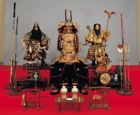Japanese Gallery (Honkan) Room 16
June 9, 2009 (Tue) - July 26, 2009 (Sun)
The origins of traditional Japanese annual events are closely connected to rice cultivation and the Chinese calendar. From the 8th to the 9th century, a system of annual events was established in the imperial court, and although regionally specific events were carried out by the general populace, many events of the noble and warrior classes spread to the wider public in the Edo period (1603-1868).
Five seasonal festivals were designated as national holidays by the Edo shogunate. These five festivals followed the traditional seasonal rituals of the imperial court, and were held on dates which mark major turning points of the seasons in order to exorcize evil spirits. Customs for the Doll Festival for girls on March 3, Boy's Festival (Children's Day) on May 5 and Tanabata (Star Festival) on July 7 are examples of traditional events still widely practiced in people's homes.
This exhibition introduces the ancient nobles' sport of kemari, depicted in the Illustrated Scroll of Annual Events, through costumes and equipment. In addition, an impressive set of Boy's Festival dolls from the Taisho period is on view, which includes not only the usual armor, but also specific characters symbolizing strength: Shoki, Emperor Jinmu (the large doll), Minamoto no Yoriyoshi and Kato Kiyomasa (the small doll). These and other representations of seasonal customs and pastimes provide an interesting overview of traditional annual events in Japan.

